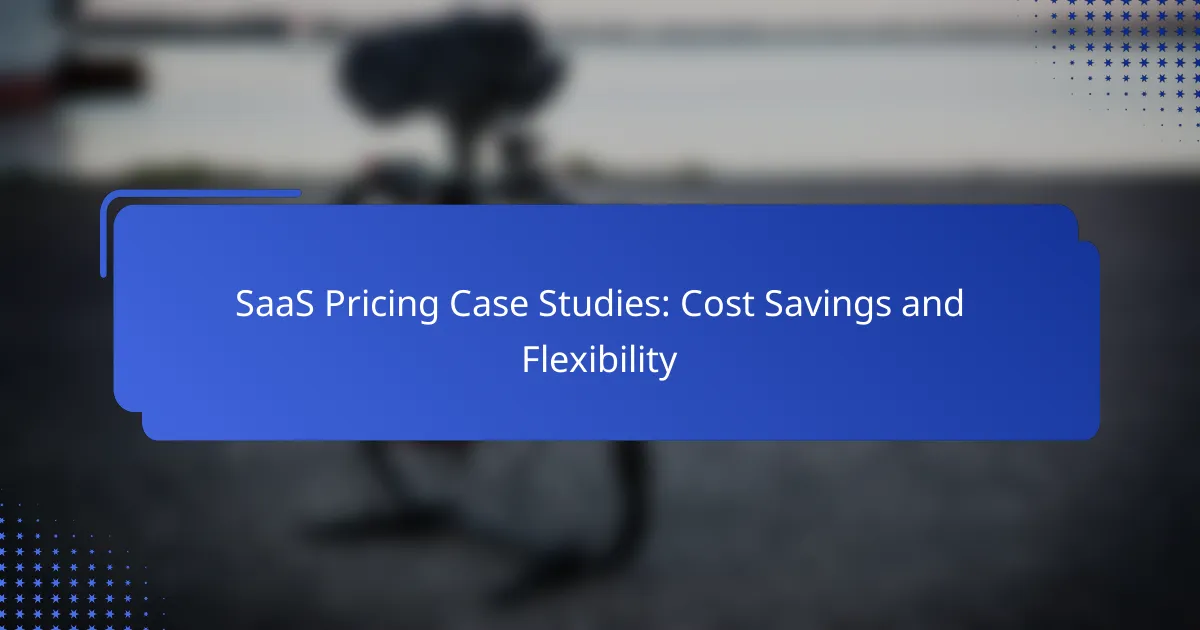SaaS pricing models present a valuable opportunity for businesses to achieve cost savings and flexibility in their software expenditures. By utilizing subscription-based services, organizations can avoid hefty upfront costs and adjust their usage based on specific needs. This adaptability not only enhances budget management but also allows for better resource allocation, making SaaS an appealing choice for many companies.

How can SaaS pricing models lead to cost savings in Canada?
SaaS pricing models can significantly reduce costs for Canadian businesses by offering flexible payment options and eliminating the need for substantial upfront investments. By leveraging subscription-based services, companies can better manage their budgets and scale their usage according to their needs.
Subscription-based pricing
Subscription-based pricing allows businesses to pay a fixed monthly or annual fee for access to software services. This model helps companies avoid large one-time costs associated with traditional software purchases, making it easier to forecast expenses. For example, a small business in Canada might pay around CAD 50 to CAD 200 per month depending on the software’s features.
Moreover, this model often includes updates and support, which can further reduce costs related to maintenance and upgrades. Companies should evaluate their usage patterns to choose the most cost-effective subscription plan.
Pay-as-you-go flexibility
Pay-as-you-go pricing offers businesses the flexibility to pay only for the services they actually use. This model is particularly beneficial for companies with fluctuating workloads, as it allows them to scale their usage up or down without incurring unnecessary costs. For instance, a Canadian startup may only pay for additional storage or user licenses during peak project periods.
This approach can lead to significant savings, especially for businesses that experience seasonal variations in demand. However, companies should monitor their usage closely to avoid unexpected charges.
Tiered pricing structures
Tiered pricing structures provide different levels of service at varying price points, allowing businesses to choose a plan that best fits their needs and budget. For example, a Canadian SaaS provider might offer basic, standard, and premium tiers priced from CAD 30 to CAD 150 per month, each with increasing features and capabilities.
This model encourages businesses to start with a lower tier and upgrade as their needs grow, ensuring they only pay for what they require. Companies should assess their current and future needs to select the most appropriate tier without overspending.
Volume discounts
Volume discounts reward businesses that purchase multiple licenses or services, leading to lower per-unit costs. For example, a Canadian company that buys ten user licenses might receive a 20% discount compared to purchasing them individually. This can result in substantial savings for larger teams.
When negotiating with SaaS providers, businesses should inquire about volume pricing options and consider consolidating purchases to maximize discounts. It’s essential to calculate the total cost of ownership to ensure the best deal is achieved.
Bundled services
Bundled services combine multiple software offerings into a single package, often at a reduced rate compared to purchasing each service separately. For instance, a Canadian company might find a bundle that includes project management, communication, and file storage tools for a flat monthly fee, potentially saving hundreds of dollars annually.
This model can simplify billing and management while providing comprehensive solutions tailored to specific business needs. Companies should evaluate the included services to ensure they align with their operational requirements and avoid paying for unnecessary features.
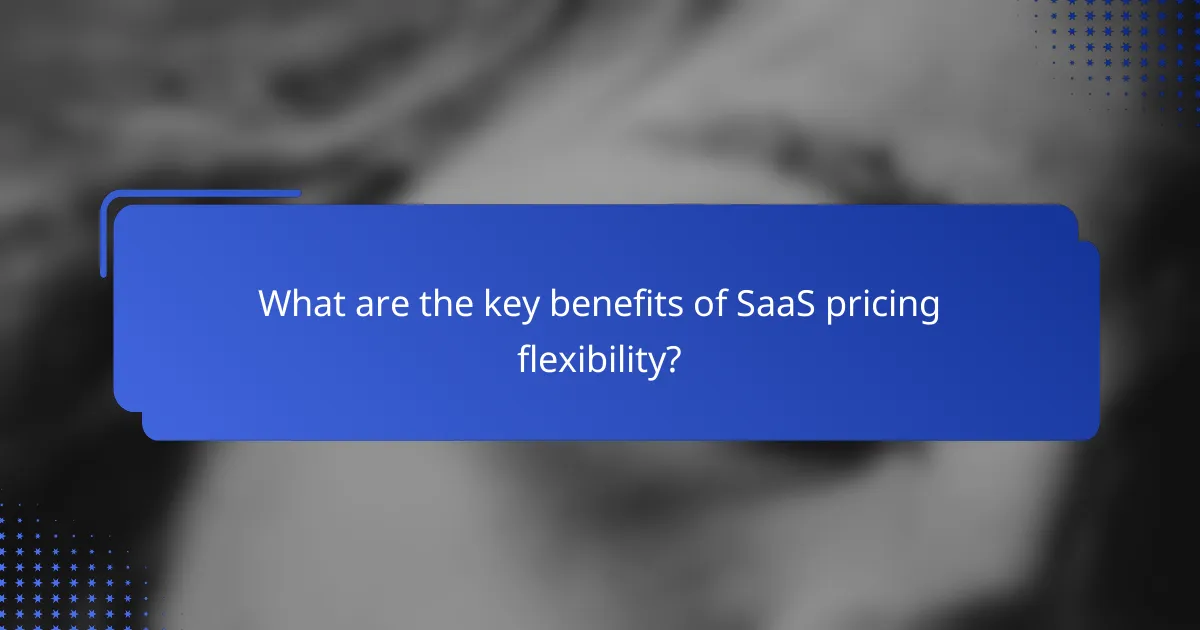
What are the key benefits of SaaS pricing flexibility?
SaaS pricing flexibility offers businesses the ability to adapt their software costs based on usage and needs. This adaptability can lead to significant cost savings and improved resource allocation, making it an attractive option for many organizations.
Scalability for growing businesses
Scalability is a major advantage of SaaS pricing flexibility, allowing businesses to adjust their subscriptions as they grow. Companies can start with basic plans and upgrade to more comprehensive packages as their needs increase, ensuring they only pay for what they use.
This model supports rapid growth without the burden of large, fixed costs. For instance, a startup can begin with a low-tier plan and scale up to a premium option as their user base expands, often without significant disruptions to their operations.
Reduced upfront costs
SaaS pricing flexibility significantly lowers upfront costs compared to traditional software purchases. Businesses typically avoid hefty licensing fees and hardware investments, opting instead for monthly or annual subscription fees that fit their budget.
This financial model allows companies to allocate resources more effectively, investing in other critical areas such as marketing or product development. For example, a small business might spend a few hundred dollars monthly on a SaaS solution rather than thousands on a one-time software purchase.
Customizable plans
Customizable plans are a hallmark of SaaS pricing flexibility, enabling businesses to tailor their subscriptions to fit specific needs. Many providers offer modular pricing structures, allowing companies to select features and services that align with their operational requirements.
This customization can lead to better resource management and cost efficiency. For instance, a company may choose to add advanced analytics features only when they are ready to leverage data insights, rather than paying for them upfront without immediate use.
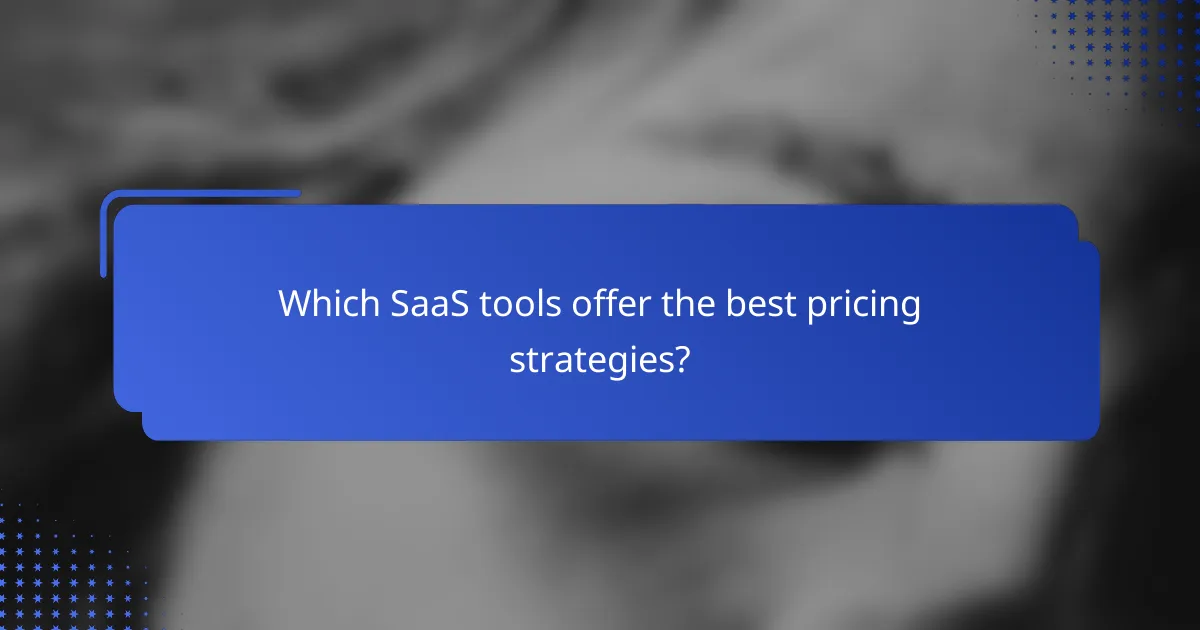
Which SaaS tools offer the best pricing strategies?
Several SaaS tools provide competitive pricing strategies that cater to various business needs. Key players like Salesforce, HubSpot, and Microsoft 365 offer flexible pricing tiers that can lead to significant cost savings and adaptability for users.
Salesforce pricing tiers
Salesforce offers multiple pricing tiers designed to accommodate different business sizes and requirements. These tiers typically range from basic plans for small businesses to advanced options for larger enterprises, with costs varying from around $25 to over $300 per user per month.
When selecting a tier, consider the features included, such as customer support, automation capabilities, and integration options. Businesses should evaluate their specific needs and potential growth to choose the most suitable plan without overspending.
HubSpot subscription options
HubSpot provides a variety of subscription options that cater to marketing, sales, and customer service needs. Their pricing starts with a free tier, which offers basic functionalities, while paid plans can range from approximately $50 to several hundred dollars per month, depending on the features and number of users.
It’s essential to assess the tools included in each subscription level, such as CRM features, marketing automation, and reporting capabilities. Businesses should consider their current and future needs to avoid paying for unnecessary features.
Microsoft 365 flexible plans
Microsoft 365 offers flexible plans that can be tailored to individual or organizational needs, with pricing typically starting around $6 per user per month for basic plans and going up to $35 for premium options. These plans include access to essential applications like Word, Excel, and Teams.
When choosing a plan, consider the number of users and the specific applications required. Microsoft 365 allows businesses to scale their subscriptions easily, making it a practical choice for growing organizations. Regularly review your plan to ensure it aligns with your evolving needs and budget.
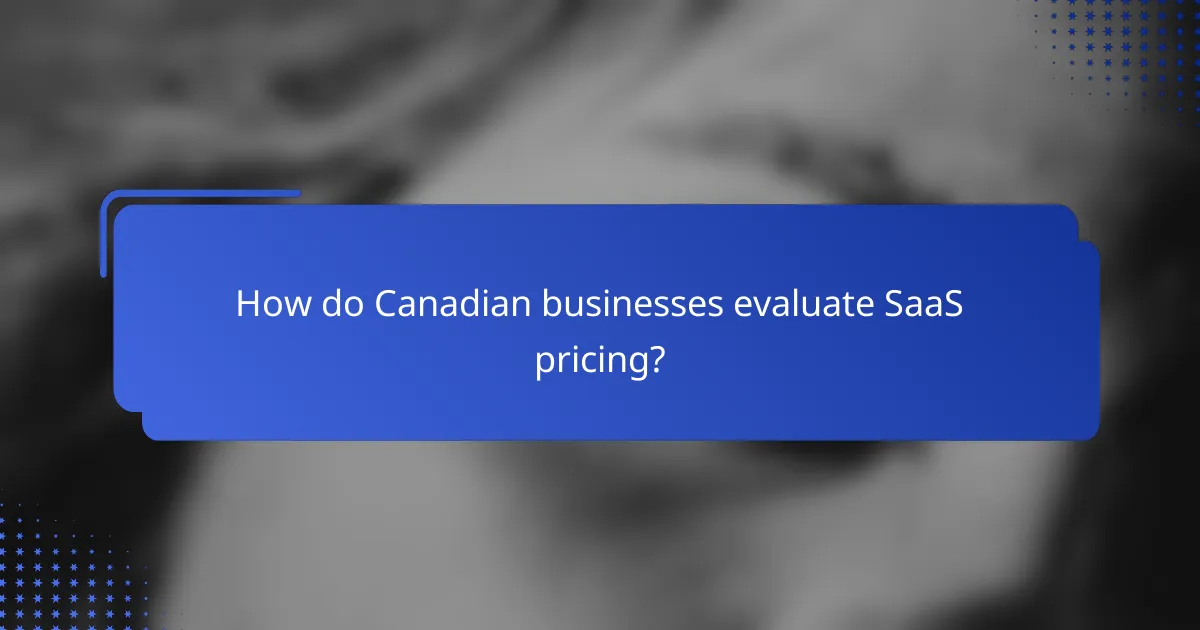
How do Canadian businesses evaluate SaaS pricing?
Canadian businesses typically evaluate SaaS pricing by assessing the overall value relative to their specific needs and budget constraints. This evaluation often involves a combination of cost-benefit analysis, feature comparisons, and trial opportunities to ensure they select the most suitable solution.
Cost-benefit analysis
Cost-benefit analysis involves comparing the total costs of a SaaS solution against the expected benefits it will deliver. Businesses should consider both direct costs, such as subscription fees, and indirect costs, like training and integration expenses.
To conduct an effective analysis, companies can calculate potential savings from increased efficiency or productivity gains. For example, if a SaaS tool can reduce project completion time by 20%, this time saving can translate into significant financial benefits over the long term.
Feature comparison charts
Feature comparison charts help businesses visually assess the capabilities of different SaaS offerings side by side. These charts can highlight key functionalities, pricing tiers, and user reviews, making it easier to identify which solutions align with specific business needs.
When creating a comparison chart, include essential features such as user limits, storage capacity, and customer support options. This structured approach allows for quick evaluations and informed decision-making.
Trial periods and demos
Trial periods and demos provide businesses with hands-on experience of a SaaS product before committing to a purchase. Many providers offer free trials lasting from a week to a month, allowing users to test features and assess usability.
During the trial, companies should focus on how well the software integrates with existing systems and whether it meets their operational requirements. Gathering feedback from team members can also help identify potential issues or advantages that may not be immediately apparent.
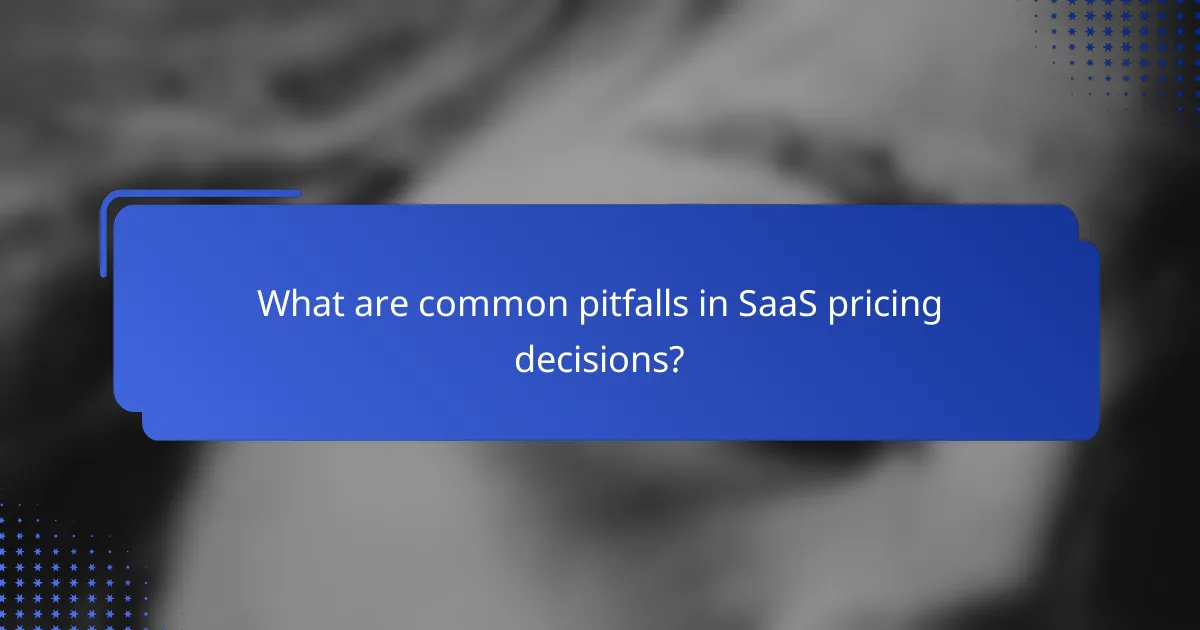
What are common pitfalls in SaaS pricing decisions?
Common pitfalls in SaaS pricing decisions include overlooking hidden costs, failing to consider long-term commitments, and neglecting the expenses associated with user training. These factors can significantly impact the overall value and effectiveness of a SaaS solution.
Ignoring hidden costs
Hidden costs in SaaS can include fees for additional features, integration expenses, or charges for exceeding usage limits. Businesses often underestimate these costs, leading to budget overruns. It’s crucial to thoroughly review pricing structures and terms to identify any potential extra charges.
For example, a SaaS provider may offer a low monthly subscription but charge extra for essential integrations or customer support. Always ask for a detailed breakdown of costs to avoid surprises.
Overlooking long-term commitments
Many SaaS providers require long-term contracts, which can lock businesses into unfavorable terms. Companies may find themselves paying for features they do not use or facing penalties for early termination. Assessing the flexibility of contract terms is essential before committing.
Consider opting for month-to-month plans if available, or negotiate terms that allow for adjustments as business needs evolve. This can provide greater financial flexibility and adaptability.
Neglecting user training expenses
Implementing a new SaaS solution often requires training for staff, which can incur additional costs. These expenses can include hiring trainers, purchasing training materials, or dedicating time for employees to learn the system. Failing to account for these costs can lead to underestimating the total investment required.
To mitigate this, factor in training costs during the budgeting process and explore whether the SaaS provider offers training resources or support. Investing in proper training can enhance user adoption and maximize the benefits of the software.
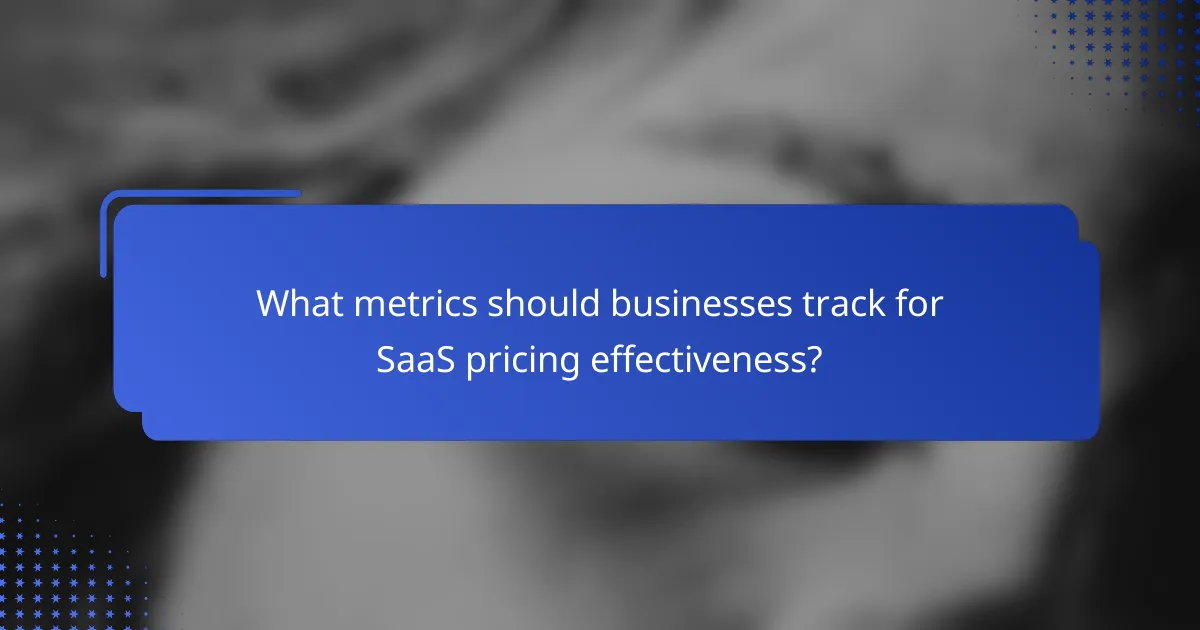
What metrics should businesses track for SaaS pricing effectiveness?
Businesses should track metrics such as customer acquisition cost (CAC), customer lifetime value (CLV), churn rate, and monthly recurring revenue (MRR) to assess SaaS pricing effectiveness. These metrics provide insights into profitability, customer retention, and overall financial health.
Customer Acquisition Cost (CAC)
Customer Acquisition Cost (CAC) measures the total cost of acquiring a new customer, including marketing and sales expenses. A lower CAC indicates more efficient spending, while a higher CAC may signal the need for improved marketing strategies. Aim for a CAC that is significantly lower than your CLV to ensure profitability.
Customer Lifetime Value (CLV)
Customer Lifetime Value (CLV) estimates the total revenue a business can expect from a customer over their entire relationship. Understanding CLV helps businesses determine how much they can afford to spend on acquiring new customers. A common benchmark is to achieve a CLV that is at least three times the CAC.
Churn Rate
The churn rate reflects the percentage of customers who discontinue their subscription within a given period. A high churn rate can indicate dissatisfaction with the service or pricing. Businesses should aim for a churn rate below 5% annually, as lower churn rates typically correlate with better customer retention and revenue stability.
Monthly Recurring Revenue (MRR)
Monthly Recurring Revenue (MRR) is the predictable revenue generated from subscriptions each month. Tracking MRR helps businesses forecast revenue and assess growth trends. To improve MRR, consider strategies such as upselling, cross-selling, or introducing tiered pricing models that cater to different customer segments.
